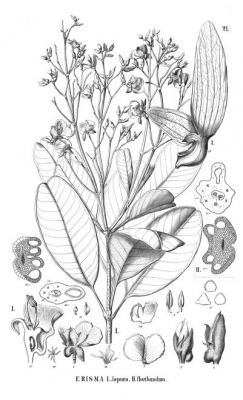Erisma japura
Spruce ex Warm.
Vochysiaceae
Common Name:
General Information
Erisma japura is a large tree.
The edible seed is gathered from the wild in quantity and used as an important food source by the local people.
Known Hazards
None known
Botanical References
Range
Northern S. America - northern Brazil, Venezuela.
Habitat
Rainforests[
562- Title
- Botanical Museum Leaflets Vol 27
- Publication
-
- Author
-
- Website
- http://www.biodiversitylibrary.org
- Publisher
- Botanical Museum; Massachusetts.
- Year
- 1979
- ISBN
-
- Description
- Contains various articles including one on the uses of Erisma japura and Monopteryx angustifolia. It can be downloaded from the Internet.
].
Properties
| Edibility Rating |      |
| Habit | Tree |
| Height | 0.00 m |
| Cultivation Status | Wild |
Cultivation Details
A plant of the humid, lowland tropics. It is found in areas where the mean annual temperature is in the region of 26°c and the mean annual rainfall is around 3,400mm. The rainfall is fairly well distributed, but there is a drier period of about 3 months[
562- Title
- Botanical Museum Leaflets Vol 27
- Publication
-
- Author
-
- Website
- http://www.biodiversitylibrary.org
- Publisher
- Botanical Museum; Massachusetts.
- Year
- 1979
- ISBN
-
- Description
- Contains various articles including one on the uses of Erisma japura and Monopteryx angustifolia. It can be downloaded from the Internet.
].
Edible Uses
Seed - raw or cooked. Pleasant eating. A pleasant, though occasionally bitter flavour[
562- Title
- Botanical Museum Leaflets Vol 27
- Publication
-
- Author
-
- Website
- http://www.biodiversitylibrary.org
- Publisher
- Botanical Museum; Massachusetts.
- Year
- 1979
- ISBN
-
- Description
- Contains various articles including one on the uses of Erisma japura and Monopteryx angustifolia. It can be downloaded from the Internet.
]. When eaten raw, they leave a thin film of wax-like fat on the roof of the mouth. Rather cashew-like in colour and texture, the edible portion of each seed weighing around 10g[
562- Title
- Botanical Museum Leaflets Vol 27
- Publication
-
- Author
-
- Website
- http://www.biodiversitylibrary.org
- Publisher
- Botanical Museum; Massachusetts.
- Year
- 1979
- ISBN
-
- Description
- Contains various articles including one on the uses of Erisma japura and Monopteryx angustifolia. It can be downloaded from the Internet.
].
A fatty oil obtained from the seed is known as 'Japura butter'[
562- Title
- Botanical Museum Leaflets Vol 27
- Publication
-
- Author
-
- Website
- http://www.biodiversitylibrary.org
- Publisher
- Botanical Museum; Massachusetts.
- Year
- 1979
- ISBN
-
- Description
- Contains various articles including one on the uses of Erisma japura and Monopteryx angustifolia. It can be downloaded from the Internet.
]. The fatty oil is extracted by boiling the fruits in water until the inner seed is cooked and the woody pericarp softened. The outer shell is then easily removed, taking with it the thin skin covering the seed. The peeled seeds are washed thoroughly in a basket. Once washed, the seeds are boiled again until very soft (about 45 minutes) and then, while still hot, either pressed through a basket sieve or crushed to a butter-like consistency with a mortar and pestle, then allowed to cool. Japura butter can be stored for up to a year in anaerobic conditions if proper care is exercised. Under such anaerobic conditions, the butter ferments, developing a sharp taste and an odour not unlike a strong cheese. People who can get over this smell find it exceedingly savoury[
562- Title
- Botanical Museum Leaflets Vol 27
- Publication
-
- Author
-
- Website
- http://www.biodiversitylibrary.org
- Publisher
- Botanical Museum; Massachusetts.
- Year
- 1979
- ISBN
-
- Description
- Contains various articles including one on the uses of Erisma japura and Monopteryx angustifolia. It can be downloaded from the Internet.
].
Medicinal
None known
Other Uses
None known
Propagation
Seed -
If you have any useful information about this plant, please leave a comment. Comments have to be approved before they are shown here.


 Useful Tropical Plants Database 2014 by
Ken Fern,
web interface by
Ajna Fern
with help from
Richard Morris.
Useful Tropical Plants Database 2014 by
Ken Fern,
web interface by
Ajna Fern
with help from
Richard Morris.